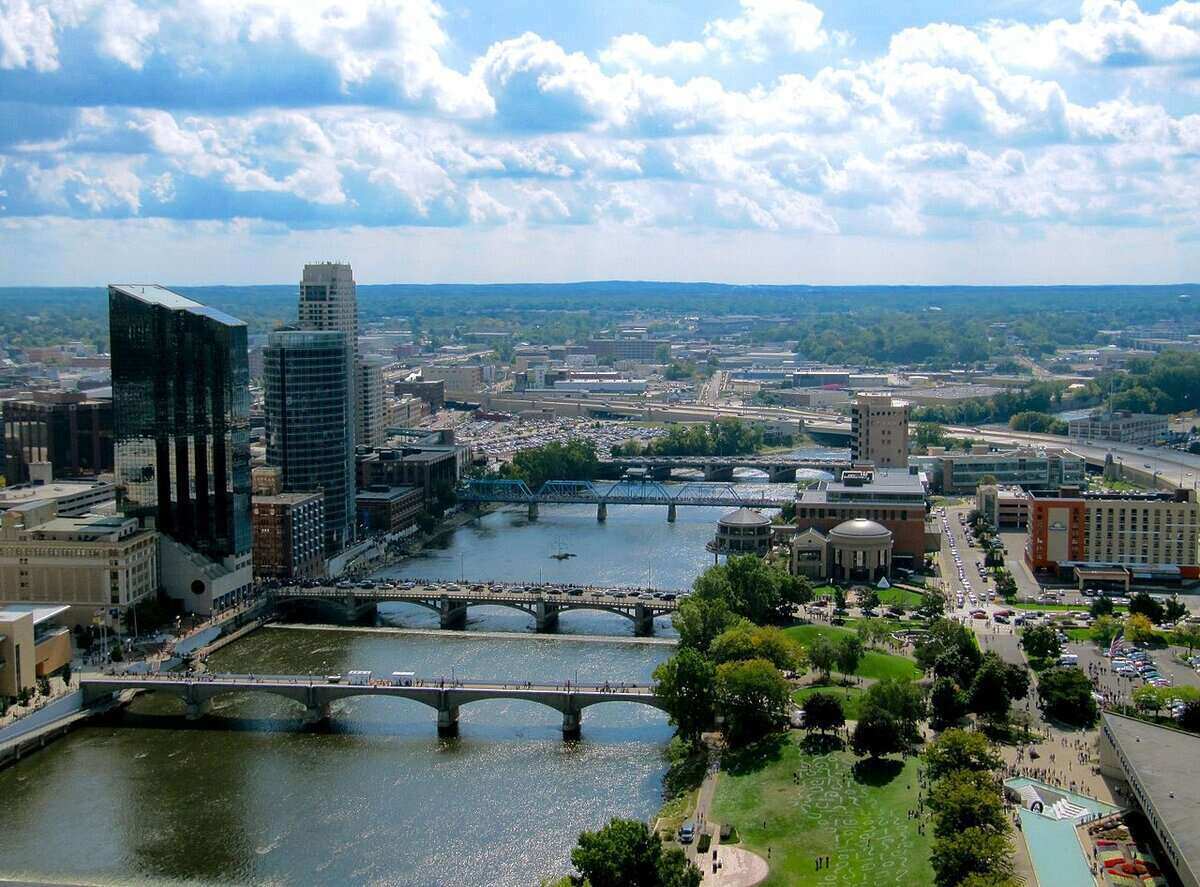
The river valley is flat and narrow, but surrounded by rolling hills that transition to forest and farmland. Its humid continental climate brings warm summers and cold and snowy winters – perfect for these four cool-season grass types.
Although the city’s proximity to Lake Michigan makes for hotter, more humid summers than most northern cities, it’s also one of the snowiest big cities in the country. That’s why these cool-season grasses produce a lush, green lawn in Grand Rapids.
1. Kentucky bluegrass

Brenda Ryan | Lawn Love
It’s the most commonly used turfgrass in Michigan because it’s durable, holds up to foot traffic, and is damage resistant. It‘s often sold in a mix or blend, and under ideal conditions, produces a dark green carpet of grass. Kentucky bluegrass is a high-maintenance lawn that requires regular fertilization and watering to keep diseases at bay.
- Classification: Cool-season grass
- Spreads by: Rhizomes
- Shade tolerance: Low
- Drought tolerance: Moderate to high*
- Foot traffic tolerance: Moderate
- Maintenance needs: *Kentucky bluegrass will go dormant without regular watering, but its rhizomes help it to recover once watering resumes. With Kentucky bluegrass, you must fertilize at 3-4 pounds of nitrogen per 1,000 square feet per year to help prevent diseases such as red thread, rust, and dollar spot. A final note: Kentucky bluegrass will develop thatch over time, so plan to remove excess thatch every few years.
- Recommended mowing height: 1.5-2.5 inches
Grass Seed Options:
– Jonathan Green (11970) Blue Panther Kentucky Bluegrass Grass Seed (3 lbs.)
– SeedRanch Midnight Kentucky Bluegrass Seed (5 lbs.)
– Jacklin Seed – Biltmore Blue Blend – 100% Kentucky Bluegrass (5 lbs.)
2. Tall fescue

Ty Haller | Flickr | CC BY-SA 2.0
Tall fescue requires much less maintenance than Kentucky bluegrass, but prefers shade and won’t hold up to foot traffic.
- Classification: Cool-season grass
- Spreads by: Depends on the variety — most are bunching, but some have short rhizomes.
- Shade tolerance: Moderate
- Drought tolerance: Low
- Foot traffic tolerance: Moderate to high
- Maintenance needs: Follow the one-third rule: Don’t remove more than one-third of the blade per cut. Plan to mow once per week.
- Mowing height: 2.5-4 inches
- Potential for disease: Moderate to high
Other notes: May thin during periods of high heat. If so, you may need to re-seed annually.
Grass Seed Options:
– Triple-Play Tall Fescue Grass Seed Blend (5000 sq ft)
– Eretz Kentucky 31 K31 Tall Fescue Grass Seed (choose your size)
– Pennington The Rebels Tall Fescue Grass Seed Mix (7 lb.)
3. Perennial ryegrass

iStock
This grass type does best in mild summers, cool winters, and lots of sunlight. Perennial ryegrass declined in popularity in the 1990s due to outbreaks of gray leaf spot. Botanists, however, have recently developed disease-resistant varieties making this grass a top favorite again.
- Classification: Cool-season grass
- Spreads by: Grows in clumps and spreads through “tillers”
- Shade tolerance: Low to moderate
- Drought tolerance: Moderate
- Foot traffic tolerance: Moderate to high
- Maintenance needs: Regular fertilization. Does not form thatch.
- Recommended mowing height: Mow to 1.5-2.5 inches
Grass Seed Options:
– Outsidepride Perennial Ryegrass Seed (5 lbs.)
– Eretz ProTurf Perennial Ryegrass Fine Lawn Seed (choose your size)
4. Fine fescues

Matt Lavin | Flickr | CC BY-SA 2.0
Red, hard, and chewings fescues work well in the shade and are often used in mixtures. Fine fescues have a high level of shade tolerance and are often combined with Kentucky bluegrass in a sun/shade grass seed mix. Other advantages are that fine fescues are highly drought tolerant and have a very low fertilization requirement.
If your lawn receives a lot of foot traffic, you may want to consider another grass. Fine fescues do not hold up well under high levels of wear.
- Classification: Cool-season grass
- Spreads by: Red fescue spread by below-ground rhizomes, while hard and chewings fescues are bunch forming and spread through tillers.
- Shade tolerance: High
- Drought tolerance: High
- Foot traffic tolerance: Low to moderate
- Maintenance needs: Weed control, some fertilization
- Recommended mowing height: Mow to 3 to 4-inches
Although Grand Rapids doesn’t have any specific lawn watering restrictions, you should avoid watering your lawn between 10 a.m. and 6 p.m., when the sun is likely to evaporate the moisture. Early morning is always best since nighttime irrigation can invite pests and disease.
Grass Seed Options:
– Outsidepride Legacy Fine Fescue Grass Seed (5 lbs.)
– Eretz Creeping Red Fine Fescue Seed (choose your size)
– Outsidepride Creeping Red Fine Fescue Grass Seed (25 lbs.)
– Outsidepride Hard Fine Fescue Grass Seed (10 lbs.)
How to select the best grass type for your lawn
Before you choose your turf, take a look at the requirements of your yard.
If you have a lot of trees shading your yard, fine fescues are your best option. If your yard is exposed to more sun, Kentucky bluegrass and perennial ryegrass are the best choices.
Fine Fescues and Kentucky bluegrass can hold up in drought conditions and need very little watering.
Tall fescue is a very low-maintenance grass for Grand Rapids yards.
If you like to spend a lot of time outside entertaining and running around the yard then choose perennial ryegrass or tall fescue.
Now that you’ve learned about several Grand Rapids-friendly grass types, all that is left is to buy the seed.
If you’d prefer to leave your capital lawn care to an expert, look to one of our local Grand Rapids Professionals to mow, edge, blow, and make your lawn worthy of anyone’s vote.
Main Photo Credit: Rachel Kramer | Wikimedia Commons | CC BY 2.0
Lawn Love participates in the Amazon Services LLC Associates Program, an affiliate advertising program. Lawn Love may earn revenue from products promoted in this article.